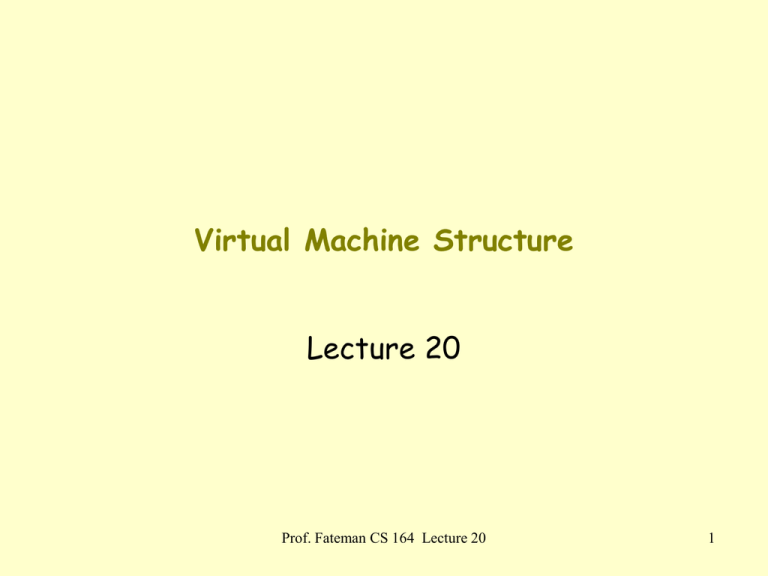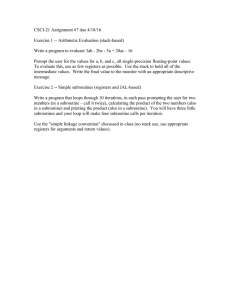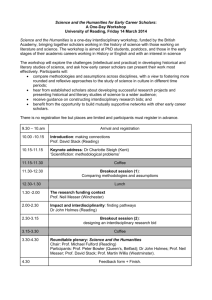Virtual Machine Structure Lecture 20 Prof. Fateman CS 164 Lecture 20 1
advertisement

Virtual Machine Structure
Lecture 20
Prof. Fateman CS 164 Lecture 20
1
Basics of the MJ Virtual Machine
Word addressed (in many other machines we are forever
shifting by 2 bits to get from words to bytes or back.)
All instructions (appear to) fit in a single word. All
integers fit in a single word. Everything else is
“pointed to” and all pointers fit in a single word.
A minimum set of operations for MJ, but these could be
expanded easily.
All arithmetic operations use a stack.
Prof. Fateman CS 164 Lecture 20
2
Why a stack?
•The usual alternative is: a pile of registers.
•Why use registers in IC?
•Many, (all?) current architectures have registers.
•If you want to control efficiency, you need to know
how to save/restore/spill registers.
•It is not too hard, if you have enough of them.
•Why use a stack?
•Some architectures historically were stack-dependent
because they had few registers (like 4, or 16..).
•Some current architectures use a stack e.g. for
floats in Pentium, 8 values.
•Minimize complexity for code generation.
Prof. Fateman CS 164 Lecture 20
3
Why a stack? Are registers more work for IC?
•Generating code to load data into registers initially
seems more complicated,
• Not by much: the compiler can keep track of which
register has a value [perhaps by keeping a stack of
variable-value pairs while generating code],
•And you did this in CS61c, but in your head, probably.
•With a finite number of registers there is always the
possibility of running out: “spill” to a stack? Or…
•(New architectures with 128 registers or more make
running out unlikely but then what?: perhaps “error,
expression too complicated, compiler fails”?).
•Opportunity to optimize: rearrange expressions to use
minimum number of registers. Good CS theory problem
related to graph coloring. (In practice, registers are
finicky, aligned, paired, special purpose,…)
Prof. Fateman CS 164 Lecture 20
4
Instructions: stack manipulation
pushi x
push immediate the constant x on the top of the stack
used only for literals. Same as iconst. e.g. (iconst 43)
Only 24 bits for x(?). (larger consts in 2 steps??)
pusha x
push address. pushes the address of x on stack.
e.g. pusha ="hello world". We assume the assembler will
find some place for x.
Same as sconst. e.g. (sconst "hello")
pop
pops top of stack; value is lost
dup pushes duplicate of top of stack
swap guess
Prof. Fateman CS 164 Lecture 20
5
A simple call / the thinking..
Consider a method
public int function F(){return 3; /*here*/
}
How might we compile F() ? Set up a label L001 for location /*here*/.
Save it on the stack.
Push the address of F on the stack.
Execute a (callj 0) to call F, a function of 0 args
Execute an (args 0) /* get params, here none {what about THIS}*/
the stack looks like
L001
3
Execute a (return). Which jumps to L001, leaving 3 on the stack.
(exit 0)
Prof. Fateman CS 164 Lecture 20
6
A simple call/ the program
public int function F(){return 3; /*here*/
}
(save L001)
(lvar 1 0) // magic… get address of f on stack.. Details follow
(callj 0) // call function of 0 args
L001:
// label to return to
(exit 0)
The program f looks like
(args 0) // collect 0 arguments into environment..
(pushi 3)
(return)
Prof. Fateman CS 164 Lecture 20
7
More fun, less work, look at SCAM
(setf *fact-test* (compile-scam
'( (define (main)
(print (factorial 5)))
(define (factorial n)
(if n
(* n (factorial (- n 1)))
1)))))
Prof. Fateman CS 164 Lecture 20
8
More fun, less work, look at SCAM
(setf *fact-test* (compile-scam
'( (define (main)
(print (factorial 5)))
(define (factorial n)
(if n
(* n (factorial (- n 1)))
1)))))
(pprint-code *fact-test*)
(run-vm (make-vm-state :code (assemble
*fact-test*)))
Prof. Fateman CS 164 Lecture 20
9





